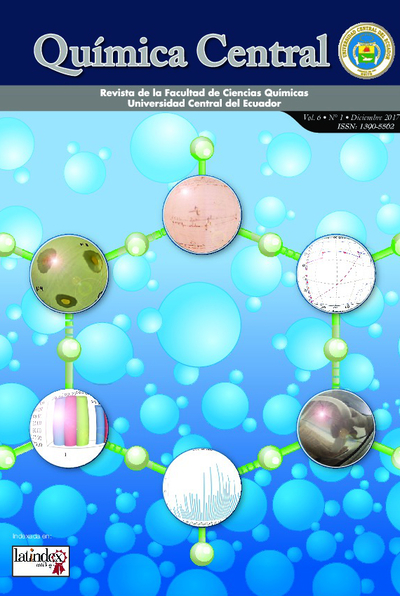Determinación de la eficiencia de un producto fijador para la protección de tintas ferrogálicas
DOI:
https://doi.org/10.29166/quimica.v6i1.1415Keywords:
Inks, ink fixer, , polystyrene,, dioctyl phthalate, orange oil.Abstract
The objective of this publication is to disseminate the results of the formulation and evaluation of an alternative fixer of iron-gall inks developed in the Historical Area of the Central University of Ecuador, which is used to protect the content of patrimonial documents. Polystyrene, di (2-ethylhexyl) phthalate (DOP) and orange oil were used as components, thereby avoiding the use of aromatic solvents. To evaluate it, the iron content was quantified by atomic absorption, present in the residual water of the treatment that regulates the pH of a document, as a result, iron contents were not found in the documents in which the fixer was applied. The effect of the fixer on the documents was also analyzed considering a before and after use of the fixer, a survey administered to 20 conservation experts, in which parameters such as the color and intensity of the documents, presence of brightness and foreign substances, concluded that 82% of the respondents did not observe changes in color and intensity, 83% affirmed there is no shine when applying the fixer, and finally 77% determined a reduction in the presence of spots.
Downloads
References
C. C. y. V. Viñas, «Las Tintas, Elementos graficos del documento,» de La preservación y restauración de documentos y libros en papel: un estudio del RAMP con directrices., París, UNESCO, 1984, p. 15.
J. V. Peris, Conervación y Restauración de material cultural en Archivos y Bibliotecas, Valencia-España: Pentagraf Impresores, S.L., 2002, p. 29.
G. H. y. A. A. Hopkins, «Tintas, Papeles, Lápices, Lacres etc.,» de El recetario industrial, Barcelona, Gustavo Gili, SL, 1994, p. 1179.
O. C. y. M. Lazzari, «Photo-oxidative stability of paraloid acrilic protective polymers,» ELSEVIER, pp. 17-21, 2000.
A. C. Rodríguez, «Barnices sintéticos : estudio comparativo de barnices sintéticos utilizados en la restauración de ceramicas,» vol. 6, nº 29–46, 2002.
«UNESCO,» 19 Noviembre 2004. [En línea]. Available: http://www.unesco.org/culture/natlaws/media/pdf/ecuador/ec_codificacion_27_ley_de_patrimonio_cultural_spaorof.pdf. [Último acceso: 7 Julio 2015].
A. E. Q. Valle, «Utilización de residuos de cáscara de naranja para la preparación de un desengrasante doméstico e industrial,» Quito, 2009.
F. Kiekeben, «nontoxicprint,» 2015. [En línea]. Available: http://www.nontoxicprint.com/safesolvents.htm. [Último acceso: 3 Julio 2015].
V. y. C. P. Bernal, «Extracción del aceite esencial de la cáscara de naranja: caracterización y estudio de potencial industria en el Ecuador,» Quito, 2012.
P. M. &. S. E. Mo ys, «Aspectos ger ais do poliestireno,» v ol. 16, 2002.
R. &. R. H. Navarro, «Plastificantes de todo tipo.» vol. 103(664), nº 14-19, 2012.
S. P. Prades, «Universidad Politeécnica de Valencia,» 15 Enero 2009. [En línea]. Available: https://www.upo.es/moleqla/export/sites/moleqla/documentos/Numero18/Peirx_Pradesx_Sara_Molequla_xPilarx.pdf.
Downloads
Published
How to Cite
Issue
Section
License
Los originales publicados en las ediciones impresa y electrónica de esta revista QUÍMICA CENTRAL son propiedad de la Universidad Central del Ecuador, siendo necesario citar la procedencia en cualquier reproducción parcial o total.
La propiedad intelectual de los artículos publicados en revista QUÍMICA CENTRAL pertenece al/la/los/las autor/a/es/as, y los derechos de explotación y difusión científica están direccionados para la revista QUÍMICA CENTRAL mediante CARTA DE AUTORIZACIÓN DE PUBLICACIÓN publicada en esta plataforma.


